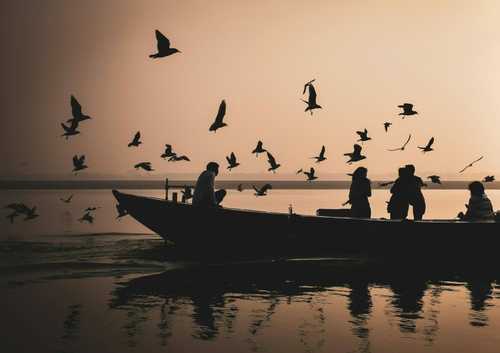
Turkish fisherman Adem Yılmaz would undoubtedly answer in the affirmative. Every spring, after spending half the year in Africa, migratory storks return to Adem’s lakeside Turkish village of Eskikaraağaç. In 2011, one such bird, a “fragile silhouette”, landed in his fishing boat. He fed it fish, and every year since the heron has returned to reunite with its human friend. The heron is known to the whole of Türkiye as Yaren (“best friend”).
Examples of this kind of human-bird relationship are not as rare as you might imagine. But, before delving any further, it might be helpful to ask another question:
Can birds make friends with each other?
As it turns out… yes, they can. Defined as “spending time together outside of immediate family groups, grooming each other, playing together, [and] helping each other out”, various studies show that birds of many kinds do all of these things.
‘Evaluating the Social Networks of Four Flocks of Captive Flamingos over a Five-Year Period: Temporal, Environmental, Group and Health Influences on Assortment’ – a snappily titled paper written by a team from the UK’s University of Exeter – established the complex social lives of these long-lived birds (which have a life expectancy of 20 to 30 years in the wild and 50 in captivity). They consistently spend time with particular individuals (in duos, trios, and quartets), maintaining these stable friendships over periods of year – while also avoiding other individuals with whom they get on less well. The writers concluded that flamingo societies are “formed of long-standing preferential partnerships and not loose, random connections”, implying that this sort of social bonding “convey[s] fitness benefits” which are beneficial to survival in the wild. 🦩
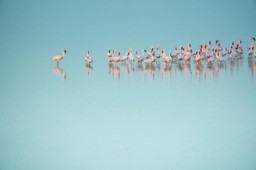
Like human friendships, then, the social relationships of birds are not exclusively altruistic: “Helping each other out always runs the risk of exploitation.” However, reciprocity can be seen in the relationships between corvids (birds of the crow family, which are considered the most intelligent birds, on a par with the non-human great apes), for example in mutual preening, food sharing, or warning each other of danger. Young ravens (who also “form long-lasting friendships based on mutual trust and cooperation”), which typically search for food alone, have also been observed recruiting a group of companions to chase older birds away from carrion in order to eat it themselves.
Other bird species known to exhibit friendship behaviors include pigeons (which remember and approach specific individuals in a crowd, and even share nests as a form of social bonding); geese (which choose to pair up with the same partners for their migratory flights each year); and vulturine guineafowl, ground-feeding birds from the same taxonomic order as chicken, turkeys, pheasants, and peacocks (which, during journeys of up to 9 miles [15 km] per day across central Kenya, have been observed to maintain distinct communal groups).
So, can humans and birds make friends?
Many stories, both historic and contemporary, suggest that this can be the case. Let’s take a look at a couple of specific examples:
Corvids
Returning to the crow family yields a rash of human-bird interactions documented on social media. One Virginia, US, resident, who feeds a local family of crows twice a day, has become so recognizable to the birds that if one encounters her in the neighborhood, “it will call to the others, and they’ll surround her and make a bunch of noise”. Other social media videos which show users’ relationships with crows demonstrate the birds’ predilection for watching their human friends, flying alongside their cars, and even delivering gifts such as shells or small snakes to them.
The seemingly mutual fascination between humans and corvids could be connected to certain similarities in the type of intelligence that we share; crows have been shown to have the ability to “ponder the content of their own minds, a manifestation of higher intelligence and analytical thought”. Other capabilities which seem remarkably human – and, indeed, were once considered to be a solely human preserve – include “self-recognition, insight, revenge, tool use, mental time travel, deceit, murder, language, play, calculated risk taking, social learning, and traditions”. A University of Washington study has even established that crows are not only capable of recognizing and remembering specific people’s faces as friendly or unfriendly, but to share that knowledge with other members of their species.
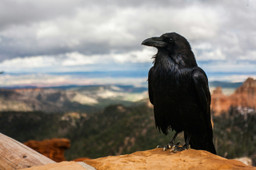
While this information might be a surprise to western science, a cross-cultural range of nonagricultural societies (societies not inclined to see birds as vermin) shows that high intelligence has historically been ascribed to crows, which “are often regarded as tricksters, allies, and sacred beings” (for example, in Viking, Nuer, and Nenet culture). In the 19th century, Vietnamese people even kept semi-domesticated crows “because of their extraordinary intelligence and ability to communicate” (and the belief that they were able to recognize individuals), and were used as avian ‘watchdogs’.
The greater honeyguide
This starling-sized relative of the woodpecker subsists primarily upon bees’ nests, eating the insects’ eggs, larvae, and pupae, and even beeswax (being one of only a few bird species able to digest it).
As implied by its name, the honeyguide is also known for an even more unique behavior: by attracting attention with its call, it will lead humans to the location of bees’ nests in its territory. Once the bees have been calmed with smoke and the honey harvested by the grateful humans, the bird can feast on the exposed wax and larvae-filled comb. This “unlikely business arrangement” has been recorded in various regions of Africa since the 1500s. However, “ethnographic reports, examples of Paleolithic rock art, and evidence from non-human primates” suggest that early hominins harvested honey from beehives, with both honey and bee larvae being “vital to human evolution and the development of early man’s large brain”. Therefore, it could be that human-honeyguide interactions originated far earlier than the 16th century. Even in the modern day, a study of the Hadza people in northern Tanzania showed that as much as 10% of their diet continues to be derived from collaboration with honeyguides.
While it’s a bit of a stretch to call a relationship with such obvious benefits a friendship (despite the reciprocity of those benefits), the extent to which it is established is impressive. A recent study showed that, as well as calling to attract human attention, the birds recognize and respond to specialized human signals in turn, having come to associate them with the potential benefit of a meal gained with a minimal outlay of energy. Ultimately, this interspecies behavior implies that humans and honeyguides have “coevolved in response to each other”.
However, there is a darker side to the honeyguides which warns against anthropomorphizing animal behavior along the lines of human motives like generosity. Like cuckoos, these birds are brood parasites, laying their eggs into the nest of other bird species, where, “minutes after entering the world, [the] chicks turn murderous, using the barbed ends of their beaks to slay their nest mates”.
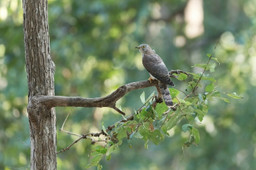
Nevertheless, human/honeyguide communication is unique in nature, standing as “the only known example of targeted two-way signals between people and a free-living species”. And, for both species, the value of this relationship is borne out by a statistic from Mozambique, where honey hunters of the Yao people find bees’ nests 75% of the time when following honeyguides. There, the birds are particularly likely to help locate nests in response to a particular call made by the hunters: a “trill-grunt” honeyguides have learnt to associate with “willing human partner[s]”, and which means they “run a better chance of ending up with a bonanza of tasty beeswax”.
Quite how honeyguides have learnt to recognize this sound is a mystery, since, being hatched into other species’ nests, the young aren’t able to learn such things from their parents. Presumably, the predisposition to collaborate with humans must be inherited knowledge which responds to different (likely arbitrary) cues in different locations, such as a whistle in Tanzania, or, in Zambia, the sound of wood being chopped.
But, tragically, deeper insights into this riddle may never be resolved: time is running out to study this relationship (and others of its kind), since “the historical connections between humans and wild animals are becoming altered at unprecedented rates”.
So… how can we befriend birds?
The desire to interact with animals, whether wild or domesticated, may seem inherent, but various theories have been mooted to explain why this is. These include:
- People who aren’t able to sustain relationships compensating by keeping pets (which seems flawed on the basis that pets can “enhance interaction with our fellow humans by acting as ‘social facilitators’”)
- The biophilia hypothesis (the idea that we inherently pursue connections with the natural world and other forms of life)
- A desire to assert dominance
- The social support model, whereby relationships with animals provide both mental and physical benefits and “a type of relationship that fellow humans do not”, one which “complement[s] and augment[s]” human relationships. Pets, in particular, can also provide social support for their humans along the same lines as other, non-family-based social structures such as clubs or sporting activities.
It’s likely that a combination of these models explains the human desire to reach out to and connect with animals. For Jenny Odell, author of the 2019 book How to Do Nothing: Resisting the Attention Economy – which suggests “a practical philosophy to help us slow down and temporarily sidestep the forces aligned against both our mental health and long-term human survival” – developing relationships with local crows and scrub jays enabled her to access welcome feelings of groundedness. Through the eyes of these birds, she was able to benefit from seeing herself “as the human animal that [she is]”. This realization came about from, initially, “leaving a few peanuts out for the crows” – which, before they started to take notice of her offerings, made her feel “like a crazy person”.
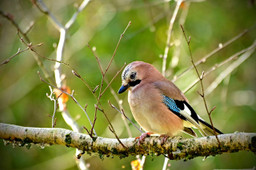
It seems that (unsalted) peanuts can be a key, then, for establishing relationships with local birds. Along with other corvids like magpies and jackdaws, pigeons, robins, and mockingbirds are also particularly able to recognise individual humans’ faces (and voices), so starting to feed them may indeed be the start of a new, lifelong friendship.
Tips on how to go about this include:
- Setting up bird feeders and nest boxes, supplying clean water in bird baths, and planting native berry shrubs
- Avoiding eye contact with birds; they dislike it because “it mimics the gaze [of] a predator”
- Speaking to them in a soft tone, allowing them to become familiar with your voice
- Not making fast or expansive movements which could scare them off
- Ensuring that pets are kept away from the area (also, give serious thought to keeping your cats indoors full time)
- Not standing closer than 10 or 12 feet (3 to 3.6 m) to your feeders, to let the birds become accustomed to your presence
- Being patient! It will take time for birds to come to trust you. 🦉
Also, if you are thinking about starting to feed birds, you should consider the following three questions:
- “Is this species at risk?” (Feeding endangered birds can have unintendedly counterproductive results)
- “Is the food appropriate and safely provided?” (Poorly maintained and badly positioned feeders can risk the spread of disease and increase the possibility of window strikes)
- “Is feeding this bird likely to change its behavior in harmful ways?” (Habituating birds to dangerous locations could be fatal.)
Good luck with your new friendships!
Featured photo by Sergio Capuzzimati on Unsplash
Earth.fm is a completely free streaming service of 1000+ nature sounds from around the world, offering natural soundscapes and guided meditations for people who wish to listen to nature, relax, and become more connected. Launched in 2022, Earth.fm is a non-profit and a 1% for the Planet Environmental Partner.
Check out our recordings of nature ambience from sound recordists and artists spanning the globe, our thematic playlists of immersive soundscapes and our Wind Is the Original Radio podcast.
You can join the Earth.fm family by signing up for our newsletter of weekly inspiration for your precious ears, or become a member to enjoy the extra Earth.fm features and goodies and support us on our mission.
Subscription fees contribute to growing our library of authentic nature sounds, research into topics like noise pollution and the connection between nature and mental wellbeing, as well as funding grants that support emerging nature sound recordists from underprivileged communities.

